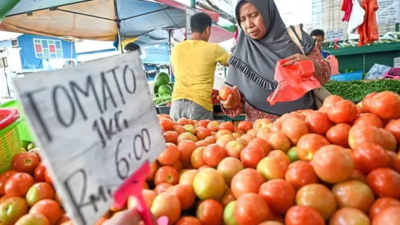
BEIJING: As December arrived, Huang Qibang and his wife Wang Juxiang looked forward to a bustling time in their village in the southwestern part of Yunnan province.
They prepared to welcome a stream of photography enthusiasts to Yangguang village, Mangshi, with the seasonal influx expected to continue until the end of April and provide a significant source of income for the couple.
“They come to capture images of the monkeys,” Wang said.
“Baby monkeys are usually born in December. They look golden and adorable and are a major draw for visiting photographers.”
The monkey is the Phayre’s leaf monkey (Trachypithecus phayrei), also known as Phayre’s langur.
They are predominantly found in the tropical, deciduous and evergreen forests of northeastern India, eastern Bangladesh and Myanmar.
In China, they are found only in the southern and southwestern parts of Yunnan.
Within the confines of Mangshi, a city close to the border with Myanmar, a patch of forest spanning approximately 1,600 hectares serves as a sanctuary for over 500 Phayre’s leaf monkeys, making it the most accessible location in the country to observe the endangered species, which is on the International Union for Conservation of Nature’s Red List of Threatened Species.
Hunting and loss of habitat are two major factors threatening the species.
Outsiders need the assistance of locals such as Huang and Wang to locate the langurs in their natural habitat.
“We are among the few monkey guides in the village,” Huang said.
“For most people hoping to observe them in the wild, our services are essential.”
Road to conservation
Huang, 43, has been familiar with the Phayre’s leaf monkey since he was a child.
With its greyish-blue fur, light-coloured areas around the eyes and mouth, and a tail nearly twice the length of its body, the langur has long been a hidden gem in the mountainous forests surrounding Mangshi in Dehong Dai and Jingpo autonomous prefecture.
As a plot of collective forest allocated to Huang’s family is part of the langur’s natural habitat, he often saw the monkeys while herding cattle or collecting wood on the mountain when he was young.
“We didn’t know their scientific name then, and neither did we know they were rare and endangered,” he said.
“We called them ‘grey monkeys’.”
In 2016, one of Huang’s friends, Yang Kaisuo, returned to the village after working elsewhere for many years, and tried to see the langurs on the nearby mountain but failed.
He later discovered that due to deforestation and habitat destruction, the monkeys were being squeezed out of their natural habitats and forced to constantly relocate to the remaining forested areas.
Yang was inspired to bring back the grey monkeys that had lived in the area for generations.
Understanding that protecting the monkeys required safeguarding their habitats, Yang asked Huang and another friend to initiate voluntary forest patrols.
Their early efforts to persuade villagers to protect the leaf monkeys and refrain from forest destruction yielded limited results.
It was during a conversation with a local wildlife photographer that Yang conceived a more effective approach.
He began helping the photographer track the langurs and capture awe-inspiring moments in 2016. The photos finally put the enigmatic creature in the limelight.
More photographers came, which in turn brought more media attention to the langurs.
In 2018, researchers from the Chinese Academy of Sciences’ Kunming Institute of Zoology visited the area and launched a comprehensive survey of the leaf monkeys.
Huang and Wang were hired by a graduate student at the institute to help him track the monkeys during his survey. He also lived in their house during his field survey.
“Every month he would come and work with us for 18 days,” Wang said.
The local volunteers learned from the researchers that monkeys were a species under first-level State protection.
They also discovered the forest, comprising part of the State-owned Mangxing Forest Farm and part of the collective forest belonging to villagers living in Xuangang township in Mangshi, was home to China’s largest known population of the species.
“We were told that about 320 leaf monkeys in five families were living in our forest,” Huang said.
In 2016, the prefecture’s forest and grassland bureau hired Huang as a patrolman to protect the collective forest. The target of his protection has since become the langurs.
It can be challenging work. From December to mid-June, he needs to patrol the forest almost every day, tracking the monkeys’ movements and eliminating any forest fire hazards.
An average patrol route is 6 kilometres, and a longer one of more than 10 km will put him on a mountain path for the whole day.
“June 15 marks the beginning of the rainy season,” Huang said.
“In the following months, I can relax a little bit and decrease the frequency of my patrols.”
While the work offered an allowance of 1,800 yuan (RM1,200) a month, that is not the reason for his persistence, especially as the local government’s budget woes meant it failed to pay him for the past two years.
However, his work has brought guests — photography enthusiasts — to the family.
“People come for our help to find the monkeys,” Huang said.
“Because of my work, more than 80 percent of them prefer our service to the others.”
Monkey guides’ routine
Every morning in December, Huang leaves his four-story house in Yangguang village at around 7 am to try to locate the langur troops as early as possible.
It’s not an easy job, or one that he can do alone.
Yang and several fellow villagers established a conservation monitoring team with the support of a local conservation NGO, and the focus of their conservation efforts gradually expanded to include other protected species in the area such as the bearcat, macaque, serow, clouded leopard and giant flying squirrel.
The team’s diligent work has received recognition and support from local government departments and research institutions.
In November 2021, they established the Mangxing River Natural Ecology Conservation Association, with Yang elected its leader.
Yang and members of his team have often joined Huang’s patrols to monitor the langurs in the forest.
“We work together to keep a close watch on the monkeys,” Huang said.
“As a result, we split the earnings generated from visiting photographers.”
They charge 200 yuan per person per day, with locating the monkeys a pre-condition for payment.
After receiving a message from her husband detailing the langurs’ location, Wang, 39, accompanies the customers to meet with Huang and his friends.
Once they find the langur troop and the customers start taking photos of the monkeys or observing them, she heads back to the family’s small plantation of dendrobium orchids, treasured herbs in traditional Chinese medicine.
The 3,300-square-metre farm is located on the mountain near the leaf monkeys’ habitat.
While there, Wang cooks lunch for her customers, charging them 30 yuan for a lunch box.
Huang’s responsibilities extend until his customers are satisfied with their photos and conclude their day. Typically, that occurs around 4 pm.
Sometimes, Wang will leave early to pick up more customers at Mangshi airport, about 15 km from the village, in the family’s four-wheel-drive vehicle, which was purchased in 2020.
“We charge 300 yuan per person for a round trip to the airport,” she said, adding that she usually makes arrangements for their customers to stay in a hotel near the village.
She said the family can earn 30,000 to 40,000 yuan a year from the guiding service, although there were few customers between 2020 and 2022 because of Covid-19 travel restrictions.
Without the income from visitors, the family had to rely on growing orchids and bee-keeping.
She maintains 20 bee colonies, which yield between 30 to 80 kilograms of honey.
“Due to excessive rainfall last year, our honey harvest was limited to 30 kg,” she said.
“The current market price for 1 kg of honey is about 100 yuan.”
Their 21-year-old daughter and 18-year-old son have no regular work and live at home after graduating from high school. The son is learning to operate an excavator.
The couple is now planning to build a bird blind to draw more birdwatchers to the village.
“An Asian emerald cuckoo has recently been hanging around in the valley where we plan to build the blind,” Huang said.
“Hopefully, more rare birds will show up and help draw more visitors to our village.”
ADVERTISEMENT
ADVERTISEMENT








































